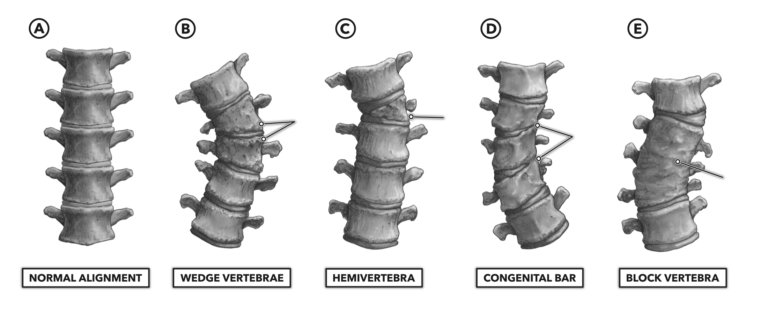Scoliosis involves the presence of abnormal curvatures along the vertebral column. The degree of scoliosis may vary dramatically from mild imperceptible curves to severe and physically perceptible deformations that limit movement capacity. Physicians diagnose any lateral deviation greater than 10 degrees from vertical as scoliosis. In the gym, it manifests as a hip or shoulder tilt when athletes should be maintaining a neutral position, level and parallel to the floor.
The precise cause of scoliosis may vary, but most often, it is congenital in nature, a result of mild to severe malformation of one or more vertebrae.
A = Normal vertebral alignment
B = Curvature inducement by partial development of one or more vertebrae — wedge vertebrae
C = Curvature inducement by complete failure of a vertebra — hemivertebra
D = Curvature inducement by partial failure of sequential vertebrae separation — congenital bar
E = Curvature inducement by complete failure of sequential vertebrae separation — block vertebrae
The onset of scoliosis, or at least the point at which it is most likely to be diagnosed, tends to be between 10 and 15 years of age. Within this age range, about one-third of one percent of children develop spinal curves that are considered severe enough to need treatment. There is no gender bias in its occurrence as there is an equivalent frequency of diagnosis among both genders during this developmental stage. However, compared to males, females are eight times more likely to have a progression in severity over their lifespan to the point of requiring treatment.
Scoliosis is usually an incidental and harmless finding that presents no risk of physical limitation. It can be visualized by simple observation, placing marks or adhesive dots along the spinous processes of sequential vertebrae. Note that scoliosis can affect lateral excursion of the vertebral column but also can change the perceived rotation of the vertebral column.
In persons with more severe scoliosis, treatment may be required to alleviate pain or reestablish respiratory capacity. Treatments may include bracing, casting, or surgical correction by vertebral fusion or rod placement. Surgical interventions are not considered until the curve is 40 degrees or greater.
As there is no “cure” for scoliosis, there are about 6 million people living with the pathology in the United States. It is important to understand that while scoliosis will be physically limiting at its most severe level of development, the vast majority of individuals with mild to moderate scoliosis can and should participate in normal physical activity. Most will never perceive any physical impairment. Usain Bolt was born with scoliosis and went on to become one of the fastest athletes of all time. Lamar Gant set world records in powerlifting with severe scoliosis. Examples abound of those with scoliosis possessing high function. In fact, limitation of activity is rarely a proper course of action; rather, the selection and execution of proper back-strengthening exercises (posterior, anterior, and lateral) should be recommended to maintain functionality over the lifespan.
To learn more about human movement and the CrossFit methodology, visit CrossFit Training.

Aberrant Vertebral Curves: Scoliosis